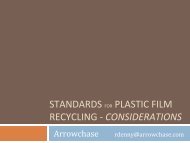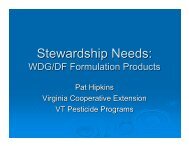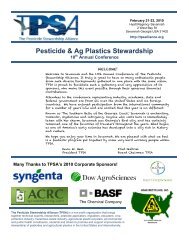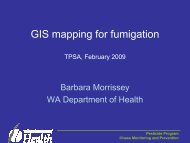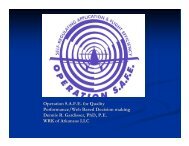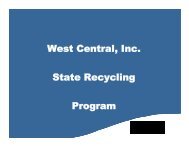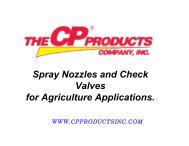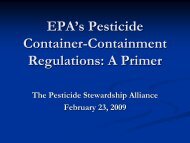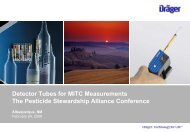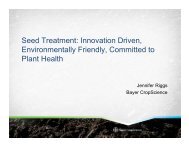Clean Sweep Programs - US Environmental Protection Agency
Clean Sweep Programs - US Environmental Protection Agency
Clean Sweep Programs - US Environmental Protection Agency
- No tags were found...
You also want an ePaper? Increase the reach of your titles
YUMPU automatically turns print PDFs into web optimized ePapers that Google loves.
Section 1 IntroductionFor the past 20 years, state and localgovernments have collected and safely disposed ofmore than 24 million pounds of unwanted pesticides.These efforts, now commonly called “<strong>Clean</strong> <strong>Sweep</strong>programs,” focus on agricultural pesticides but mayalso include other pesticides, such as those used byhomeowners, golf courses, or highway departmentsalong their rights-of-way. There is no federalstatutory requirement or mandate to conduct thesecollections. <strong>Clean</strong> <strong>Sweep</strong>s are state and localinitiatives, and the states have adopted a variety ofapproaches to finance and implement their programs.However, all of the states have the samegoal: fostering environmental protection and pollutionprevention by removing these potentially hazardousmaterials from the environment.This report is a salute to the states’successful and largely unheralded contribution tocleaning up the environment.1.1 What are the goals of this report?Tell a great story of environmental protection.The potential for soil and water contamination due tothe improper management of waste pesticides is highand is widely documented. Many state and localgovernments recognized and addressed this possibleproblem and have removed and disposed of over 24million pounds of potential contaminants.Recognize the efforts of state and local governments.State and local governments have taken thelead and largely used their own resources to developprocedures for the safe collection and disposal ofunwanted pesticides. The federal government hasplayed a limited supporting role. EPA wishes torecognize the states and counties for their accomplishments.Document <strong>Clean</strong> <strong>Sweep</strong> programs and providean accessible information database. State <strong>Clean</strong><strong>Sweep</strong> programs have many common features, buteach state has designed its program to meet its ownneeds. This report presents information on eachstate’s program in a standard format. It alsoconsolidates all of the information, allowing nationaltotals to be calculated and providing a nationwideperspective on the accomplishments of <strong>Clean</strong><strong>Sweep</strong>s. In addition, EPA plans an on-line versionof this report, which will be a living document,periodically updated as established programs changeor new ones start.Serve as a resource for regulators, lawmakers,and the public. This report provides informationfor federal, state, tribal, county and municipalofficials and citizens interested in initiating orimproving the collection of agricultural pesticides.Support national and international efforts toprevent pollution and promote environmentalprotection. Several national and international effortsattempt to prevent persistent and bioaccumulativetoxics (PBTs) from reaching the environment and toremove the PBT contamination that already exists.<strong>Clean</strong> <strong>Sweep</strong> programs ensure that existing pesticidestocks, including pesticides categorized as PBTs, areproperly collected and disposed.1.2 How do <strong>Clean</strong> <strong>Sweep</strong> programsmesh with EPA’s priorities andprograms?EPA’s mission is to protect human health andsafeguard the natural environment -- air, water, andland -- upon which life depends. <strong>Clean</strong> <strong>Sweep</strong>programs conducted and led by state and localgovernments are consistent with this mission. Theseprograms have collected and properly disposed ofmillions pounds of unwanted pesticides, therebyensuring that they will not be released as potentialcontaminants in the environment. This section brieflydescribes some of the specific EPA programs whose1



